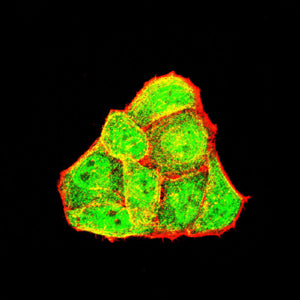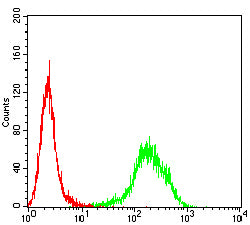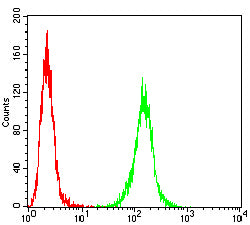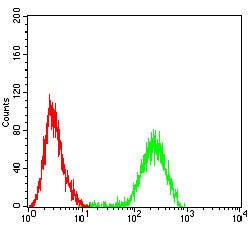




| WB | 咨询技术 | Human,Mouse,Rat |
| IF | 咨询技术 | Human,Mouse,Rat |
| IHC | 咨询技术 | Human,Mouse,Rat |
| ICC | 1/200 - 1/1000 | Human,Mouse,Rat |
| FCM | 1/200 - 1/400 | Human,Mouse,Rat |
| Elisa | 1/10000 | Human,Mouse,Rat |
| Aliases | NER; UNR; LXRB; LXR-b; NER-I; RIP15 |
| Entrez GeneID | 7376 |
| clone | 5C11D3 |
| WB Predicted band size | 51kDa |
| Host/Isotype | Mouse IgG2b |
| Antibody Type | Primary antibody |
| Storage | Store at 4°C short term. Aliquot and store at -20°C long term. Avoid freeze/thaw cycles. |
| Species Reactivity | Human |
| Immunogen | Purified recombinant fragment of human NR1H2 (AA:1-200) expressed in E. Coli. |
| Formulation | Purified antibody in PBS with 0.05% sodium azide |
+ +
以下是关于NR1H2(LXRβ)抗体的参考文献示例(注:内容为示例性概括,建议通过学术数据库核实原文):
---
1. **"Characterization of liver X receptor subtypes in macrophage foam cells"**
*Joseph SB, et al. (2013)*
该研究通过Western blot和免疫荧光技术,使用NR1H2抗体验证LXRβ在巨噬细胞泡沫细胞中的表达,探讨其在胆固醇外排和炎症反应中的调控作用。
2. **"Antibody-based profiling of nuclear receptors in metabolic tissues"**
*Zhang Y, et al. (2017)*
文献开发了一种针对NR1H2的特异性抗体,并应用于免疫组化分析,揭示了LXRβ在小鼠肝脏和脂肪组织中的差异表达模式及其与代谢疾病的相关性。
3. **"LXRβ antibody modulates amyloid-beta clearance in Alzheimer's disease models"**
*Wang C, et al. (2020)*
研究利用NR1H2抗体阻断LXRβ功能,发现其可影响小胶质细胞对β-淀粉样蛋白的吞噬能力,提示LXRβ作为神经退行性疾病的潜在治疗靶点。
4. **"Differential roles of LXRα and LXRβ in lipid metabolism identified by isoform-specific antibodies"**
*Kalaany NY, et al. (2006)*
通过亚型特异性NR1H2抗体区分LXRα/LXRβ功能,证明LXRβ在肠道胆固醇吸收和胆汁酸合成中具有独特作用。
---
建议通过PubMed或Google Scholar以“NR1H2 antibody”或“LXRβ antibody”为关键词检索最新文献,以获取具体研究信息。
The NR1H2 antibody is a crucial tool for studying the nuclear receptor subfamily 1 group H member 2 (NR1H2), also known as liver X receptor beta (LXRβ). As a member of the ligand-activated nuclear receptor superfamily, NR1H2 forms heterodimers with retinoid X receptors (RXRs) and regulates gene expression by binding to specific DNA response elements. It plays a key role in lipid metabolism, cholesterol homeostasis, and inflammation by responding to oxysterols as endogenous ligands. NR1H2 is expressed ubiquitously, with high levels in the liver, adipose tissue, and macrophages.
Antibodies targeting NR1H2 enable researchers to detect and quantify its expression, localization, and interactions in various experimental models. They are widely used in techniques like Western blotting, immunohistochemistry, and chromatin immunoprecipitation (ChIP). Validated NR1H2 antibodies help investigate its regulatory mechanisms in diseases such as atherosclerosis, metabolic syndrome, and cancer. Specificity is critical, as NR1H2 shares structural homology with its isoform LXRα (NR1H3). High-quality antibodies undergo rigorous validation using knockout controls to ensure accurate detection. Research utilizing NR1H2 antibodies continues to uncover its therapeutic potential in modulating metabolic pathways and inflammatory responses, making it a focal point in drug development for cardiometabolic disorders.
×